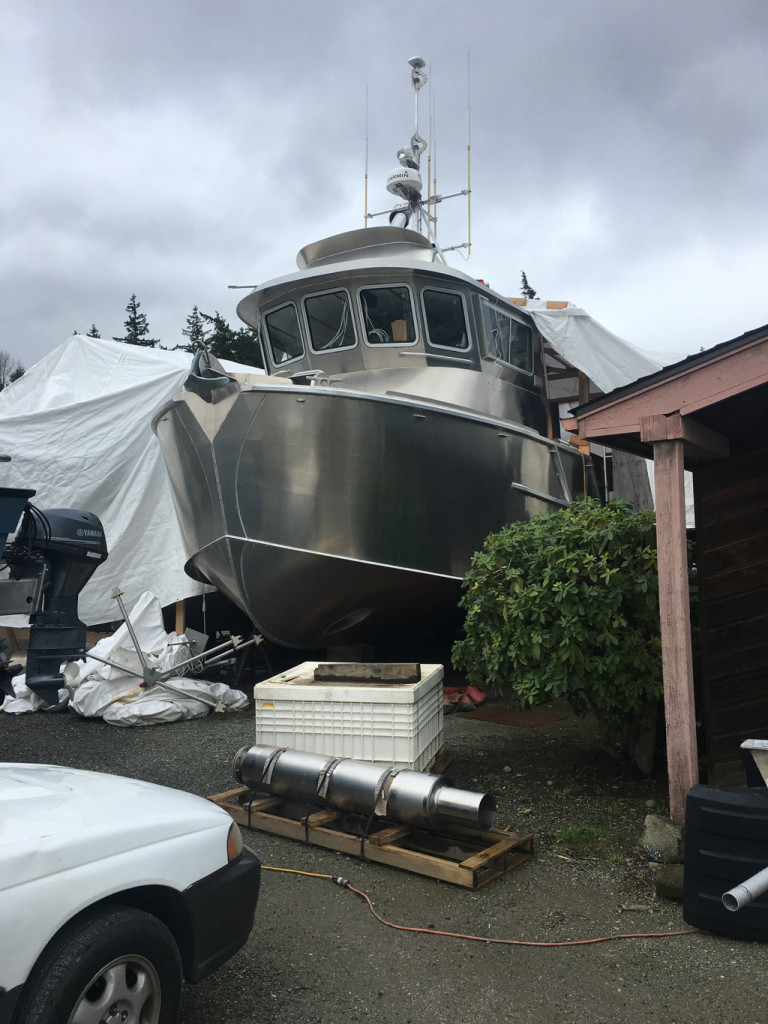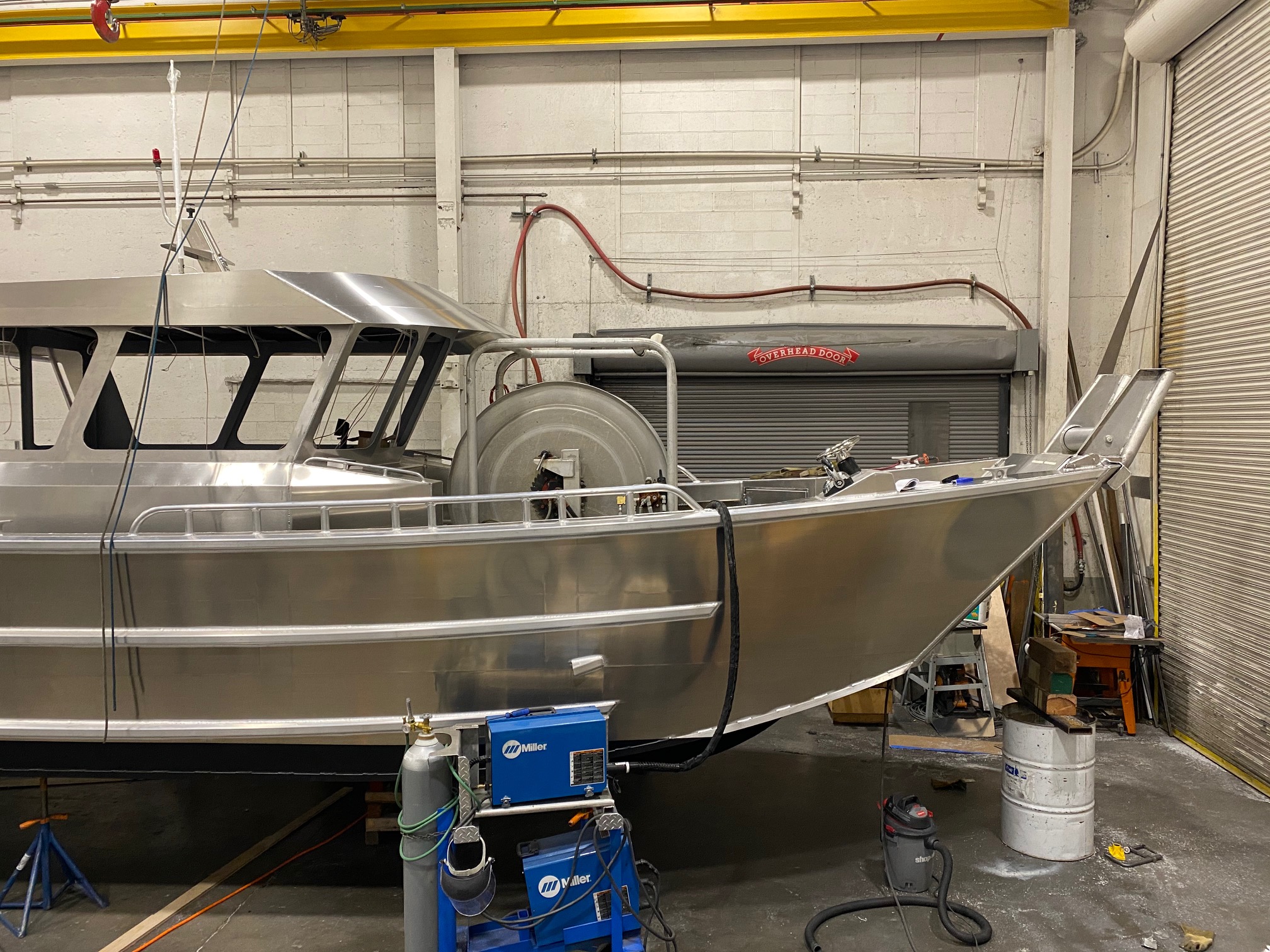Velocity Marine and Fabrication’s Rob Smith calls it “a strange one but kind of a cool one.” He’s talking about the Helisa Marie, a high-speed 33' x 11' aluminum landing craft going to Puget Sound, Wash., that’s being built at Velocity Marine and Fabrication in Sedro-Woolley, Wash.
But how many landing craft are gillnetting for salmon and crabbing when not engaged in typical landing craft work? That is what the Helisa Marie will be doing.
The landing craft’s cabin is amidships with a 12-foot length of deck in front of it for a Kinematics hydraulic drum, roller horns that bolt to the top of the landing craft’s drop door and a 13-hp Honda power pack to run the hydraulic drum when gillnetting and a hydraulic davit when crabbing. Salmon and crab will be stored in totes filled with slush ice. Then when it’s time to unload, just “roll the totes down the ramp at the dock,” says Smith. What could be easier?
Velocity Marine has built a number of landing craft and was getting ready to launch a pair of 33' x 11' landing craft at the end of February.
“I’ve never seen another one like [the Helisa Marie],” says Smith, adding that the design was the customer’s idea, though the customer had also never seen one.
When the fishing season is completed, all the machinery needed for gillnetting or crabbing will be removed, turning the Helisa Marie into a normal looking landing craft, albeit a very fast one. Mounted on the Helisa Marie’s transom are two 350-hp Suzuki outboards. Smith figures that power package will send her up to 50 mph.
On a more conventional note, Velocity Marine is building two commercial crabbers, a 36' x 13' model with twin 350-hp Suzuki outboards for a Puget Sound fisherman and a 35' x 13' crabber, whose power package had not been settled on, that’s going to Westport, Wash.
Work had just started in early February on a 26' x 10' setnet skiff for Bristol Bay. She will have a single 200-hp Yamaha outboard that will be controlled from a standup center console with a windshield.
“Most setnet skiffs are wide open,” without a center console, Smith noted. The skiff should be ready to barge up to Bristol Bay by mid-April.
Petrzelka Brothers in Mt. Vernon, Wash., a family-owned and -operated boatshop since 1977, is getting closer to shutting its doors for good.
“We are just working on our last boats,” says Jon Petrzelka. That’s two new Bristol Bay gillnetters and a couple in for repairs.

One of the new 32' x 16' gillnetters being finished off came in as a bare aluminum hull from Norcraft Marine & Design in Anacortes, Wash. She’ll go out with a TraktorJet powered by a 730-hp Scania.
“She’s a pretty deluxe package; lots of wood and Formica inside,” says Petrzelka. There’s hold capacity for 24,000 pounds that will be chilled with a PacWest RSW system.
The second new gillnetter, built by Madden Metal Works in Bellingham, Wash., at 32' x 19' is “one of the larger Bristol Bay boats that’s been built,” says Petrzelka. It arrived at Petrzelka Brothers with a cabin, a pair of 800-hp MAN diesels and two Thrustmaster jets. “It has a very shallow draft and should go really good.” She’ll pack 20,000 to 24,000 pounds and will also have a PacWest RSW system.
A gillnetter in for repairs was the Harlequin that Petrzelka Brothers rebuilt several years ago. Last May there was a fire in her engine room, which canceled the boat’s 2020 season before it started. The Harlequin was shipped down to Petrzelka Brothers. In February the crew there had nearly finished restoring her. The engine was pulled and sent out to be examined for damages and cleaned up. Destroyed wiring, hydraulic hoses and plumbing were replaced, and the interior was being repaired and cleaned.
The second repair job involves a fiberglass 32-foot Jumbo Wegley built by Wegley Boat Enterprises in Bellingham, Wash., that’s getting a major repower. An 800-hp Man went in, and a 450-hp Caterpillar was removed. That much additional horsepower meant the 22-inch prop had to be replaced with a larger 28-inch prop, which, in turn, required repositioning the shaft log and dropping the strut and the keel to accommodate the larger propeller.
“It may go pretty fast,” says Petrzelka. “No one we know put this much horsepower in a Jumbo Wegley.”







